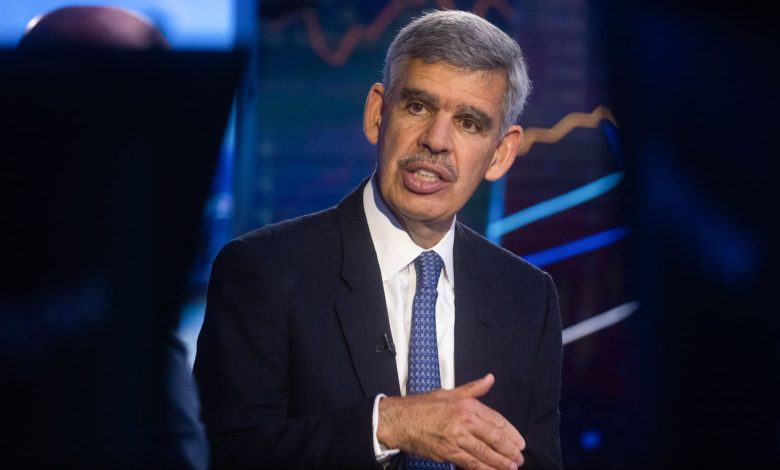Mohamed El-Erian says Trump tariffs risk US recession

Mohamed Aly El-Erian, chief economic advisor for Allianz SE.
Bloomberg | Getty Images
President Donald Trump’s extensive raft of import tariffs are putting the U.S. economy at risk of recession, Allianz’s Chief Economic Advisor Mohamed El-Erian warned on Friday.
He added that Trump’s swathe of so-called reciprocal tariffs could have a significant effect on the global economy.
“You’ve had a major repricing of growth prospects, with a recession in the U.S. going up to 50% probability, you’ve seen an increase in inflation expectations, up to 3.5%,” he told CNBC’s Silvia Amaro on the sidelines of the Ambrosetti Forum in Cernobbio, Italy.
“I don’t think [a U.S. recession] is inevitable because the structure of the economy is so strong, but the risk has become uncomfortably high.”
Trump’s tariffs are being rolled out just as signs of weakness are starting to show in the American economy. Last month, fund managers, strategists and analysts told CNBC that they saw a slowdown on the horizon, with the risk of a recession rising to a six-month high.
El-Erian said he believed the U.S. economy would expand by between 1% and 1.5% this year, noting that this represented a “significant change in the growth outlook” when compared with the IMF’s projection of 2.7% U.S. growth made earlier this year.
“If we get close to 1%, we get close to what’s known as ‘stall speed,'” he said. “The economy isn’t going fast enough to allow for the sort of resource reallocations that you need. So once you get closer to one, which I hope we don’t, the recession risk will go up significantly.”
Aside from warning about the state of the U.S. economy as tariffs come into play, El-Erian also said that markets were underestimating the inflation impact of Trump’s aggressive trade policies.
He further warned that markets were underestimating the inflation impact of the tariffs regime.
“The first reaction has been concerns about growth. We haven’t had two other reactions yet: what will happen to growth in other countries, and that makes a question mark on whether the dollar weakness will continue, and then what does the [Federal Reserve] do?” he questioned.
Last week, the latest U.S. data showed that core inflation rose more than expected, with the core personal consumption expenditures index — the Fed’s key inflation gauge — notching its biggest monthly gain in over a year.
“I think if we’re lucky we’ll get one rate cut, not four, and it wouldn’t surprise me if we get none,” El-Erian added.
“If it’s a normal Fed — and I say this qualification with a lot of emphasis, because this has not been a normal Fed — we would unlikely to get even one rate cut.”
Markets are currently pricing in four rate cuts from the Fed over the course of the year, according to the CME Group’s FedWatch tracker. At its most recent meeting in March, the central bank held its key rate steady in a range between 4.25% to 4.5%, with officials cutting their U.S. growth forecast but saying they still saw two rate cuts through 2025.
‘If the U.S. slows down, the rest of the world will slow down more’
In the immediate aftermath of Trump’s reciprocal tariffs announcement, European currencies logged significant gains against the U.S. dollar, with the euro and the British pound touching on six-month highs against the greenback.
El-Erian nevertheless said he did not expect to see long-term dollar weakness.
“The market has reacted to lower U.S. growth, lower interest rates, lower capital flows to the US, and that’s why we’ve seen the dollar index depreciate. I think that’s round one,” he said. “People are going to realize that if the U.S. slows down, the rest of the world will slow down more than the U.S. So I don’t believe we’re going to continue to see dollar weakness.”
Ultimately, El-Erian said, economists were divided on what huge import duties would mean for the American and global economies.
“While there’s, I think, complete consensus on the pain [caused by tariffs] in the short term, there’s disagreement on the gain in the long term,” he told CNBC. “Can you make a case that this is pain now for gain later? Yes. Can you make it with conviction? No.”
— CNBC’s Jeff Cox and Steve Liesman contributed to this report.



